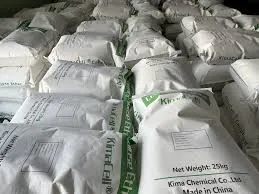
jan . 01, 2025 21:22 Back to list
Top Hydroxypropyl Methyl Cellulose Manufacturers and Their Leading Products
Hydroxypropyl Methyl Cellulose Manufacturers An Overview
Hydroxypropyl methyl cellulose (HPMC) is a versatile and widely-used cellulose ether in various industries, including pharmaceuticals, construction, food, and personal care. As a manufacturer of HPMC, it is crucial to understand both the production and market dynamics of this important compound, which is known for its thickening, binding, and film-forming properties.
What is Hydroxypropyl Methyl Cellulose?
HPMC is derived from natural cellulose, making it a non-toxic, biodegradable polymer. It is synthesized by the etherification of cellulose with propylene oxide and methyl chloride, resulting in a white, odorless powder that is soluble in cold water but not in hot water. The unique properties of HPMC make it suitable for a diverse range of applications.
Some common uses of HPMC include
1. Pharmaceuticals HPMC serves as a binder in tablet formulation, a coating agent, and in controlled-release drug delivery systems. 2. Construction In the construction industry, HPMC enhances the workability and water retention of cement-based materials, such as mortars and plasters. 3. Food Industry HPMC is utilized as a food additive, providing texture and stability to various products, including sauces, dressings, and ice creams. 4. Personal Care It acts as a thickener and stabilizer in lotions, creams, and other cosmetic formulations.
The Role of Manufacturers
Manufacturers of HPMC play a pivotal role in ensuring the material meets specific quality standards required for different applications. The production process involves several key steps
1. Raw Material Sourcing The quality of HPMC is heavily dependent on the cellulose used as the raw material. Reputable manufacturers source high-quality wood pulp or cotton linters to ensure that the final product is consistent and reliable.
2. Synthesis Process The manufacturing process must be carefully controlled to achieve the desired degree of substitution (DS) of the methoxy and hydroxypropyl groups. This parameter influences the solubility and performance of HPMC.
hydroxypropyl methyl cellulose manufacturers

3. Quality Control Manufacturers implement strict quality control measures throughout the production process. This includes testing for viscosity, purity, and consistency, followed by thorough analysis to meet food and pharmaceutical standards.
4. Packaging and Distribution After quality assurance, HPMC is packaged appropriately to preserve its integrity during storage and transport. Efficient distribution channels are crucial for timely delivery to various industries.
Market Trends and Challenges
The global demand for HPMC continues to rise, driven by advancements in the pharmaceutical and construction sectors. However, manufacturers face several challenges
1. Competition The market for HPMC is highly competitive, with numerous manufacturers vying for market share. This competition pressures companies to innovate and reduce production costs while maintaining high-quality standards.
2. Sustainability As the world shifts toward more sustainable practices, HPMC manufacturers are increasingly focusing on eco-friendly production processes and raw material sourcing. This includes the use of renewable resources and minimizing waste.
3. Regulatory Compliance Manufacturers must navigate a complex landscape of regulations, particularly in the pharmaceutical and food areas. Compliance with guidelines set by agencies such as the FDA and EFSA is essential to ensure product safety and efficacy.
4. Technological Advancements Adopting new technologies in manufacturing processes can enhance efficiency and product quality. However, initial investments in technology can be significant and may challenge smaller manufacturers.
Conclusion
Hydroxypropyl methyl cellulose is a critical ingredient across various industries, and its manufacturers play a vital role in meeting market demands. By prioritizing quality control, sustainability, and innovation, HPMC manufacturers can effectively serve their customers while navigating the challenges of a competitive landscape. As industries continue to evolve, the adaptability and resilience of HPMC manufacturers will be key to their long-term success in the market. As such, investing in research and development, coupled with a commitment to sustainability, will position these manufacturers favorably in the future.
-
Versatile Hpmc Uses in Different Industries
NewsJun.19,2025
-
Redispersible Powder's Role in Enhancing Durability of Construction Products
NewsJun.19,2025
-
Hydroxyethyl Cellulose Applications Driving Green Industrial Processes
NewsJun.19,2025
-
Exploring Different Redispersible Polymer Powder
NewsJun.19,2025
-
Choosing the Right Mortar Bonding Agent
NewsJun.19,2025
-
Applications and Significance of China Hpmc in Modern Industries
NewsJun.19,2025







